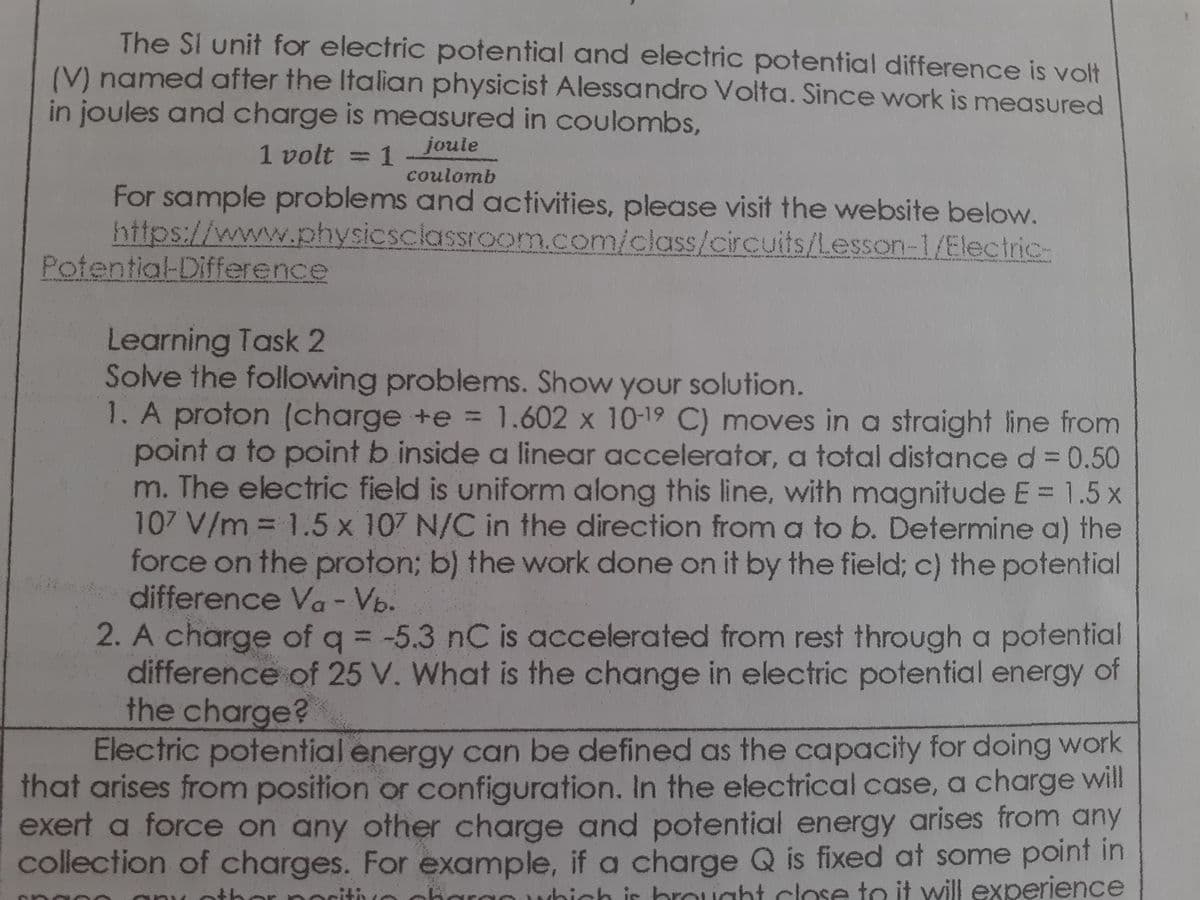The SI unit for electric potential and electric potential difference is volt (V) named after the Italian physicist Alessandro Volta. Since work is measured in joules and charge is measured in coulombs, joule
The SI unit for electric potential and electric potential difference is volt (V) named after the Italian physicist Alessandro Volta. Since work is measured in joules and charge is measured in coulombs, joule
Chapter7: Electric Potential
Section: Chapter Questions
Problem 62P: A long cylinder of aluminum of radius R meters is charged so that it has a uniform charge per unit...
Related questions
Question
100%
Hi! Can someone answer Learniing task 2, no. 1? Provide a complete solution with given, formulas, etc. Thanks!

Transcribed Image Text:The SI unit for electric potential and electric potential difference is volt
(V) named after the Italian physicist Alessandro Volta. Since work is measured
in joules and charge is measured in coulombs,
1 volt = 1
joule
%3D
coulomb
For sample problems and activities, please visit the website below.
https://www.physicsciassroom.com/class/circuits/Lesson-1/Electric-
Potential-Difference
Learning Task 2
Solve the following problems. Show your solution.
1. A proton (charge +e = 1.602 x 10-19 C) moves in a straight line from
point a to point b inside a linear accelerator, a total distance d 0.50
m. The electric field is uniform along this line, with magnitude E = 1.5 x
107 V/m = 1.5 x 107 N/C in the direction from a to b. Determine a) the
force on the proton; b) the work done on it by the field; c) the potential
difference Va - Vb.
2. A charge of q = -5.3 nC is accelerated from rest through a potential
difference of 25 V. What is the change in electric potential energy of
the charge?
Electric potential energy can be defined as the capacity for doing work
%3D
N
%3D
that arises from position or configuration. In the electrical case, a charge will
exert a force on any other charge and potential energy arises from any
collection of charges. For example, if a charge Q is fixed at some point in
noritiuo ohargo
hich ir brought close to it will experience
Expert Solution
This question has been solved!
Explore an expertly crafted, step-by-step solution for a thorough understanding of key concepts.
Step by step
Solved in 2 steps with 2 images

Knowledge Booster
Learn more about
Need a deep-dive on the concept behind this application? Look no further. Learn more about this topic, physics and related others by exploring similar questions and additional content below.Recommended textbooks for you



College Physics
Physics
ISBN:
9781938168000
Author:
Paul Peter Urone, Roger Hinrichs
Publisher:
OpenStax College



College Physics
Physics
ISBN:
9781938168000
Author:
Paul Peter Urone, Roger Hinrichs
Publisher:
OpenStax College

Physics for Scientists and Engineers: Foundations…
Physics
ISBN:
9781133939146
Author:
Katz, Debora M.
Publisher:
Cengage Learning

Glencoe Physics: Principles and Problems, Student…
Physics
ISBN:
9780078807213
Author:
Paul W. Zitzewitz
Publisher:
Glencoe/McGraw-Hill

Physics for Scientists and Engineers, Technology …
Physics
ISBN:
9781305116399
Author:
Raymond A. Serway, John W. Jewett
Publisher:
Cengage Learning